'Psychology has a long past, but only a short history." The period from the Dialexeis to William Burnham constitutes the "long past" of Ebbinghaus' aphorism, when investigations of memory were dominated by philosophical methods of introspection and rational argument.
In part, this was because those who would have investigated memory (and, for that matter, other aspects of mental life) lacked the proper tools for the purpose: no instruments, no notion of controlled methodology, no statistical techniques for data analysis. But this wasn't the only problem, because quantitative, experimental sciences of physics and chemistry began to develop long before psychology. Why physics and chemistry, and not psychology?
The bigger problem was that there was an enduring notion that it was impossible, to begin with, to have a science of the mind as we have sciences of the physical and biological worlds. This was because the mind was believed to be special, and not amenable to a scientific analysis.
The foundations for this idea had been laid by Descartes, in his doctrine of mind body dualism. According to Descartes, mind and body were composed of separate substances. Body was characterized by extension: it was composed of a material substance that takes up space. By contrast, mind was composed of immaterial thought. Descartes understood that mind and body interact: the sense organs and the brain mediate perception of the outside world, and thoughts cause bodily actions to occur. Descartes inferred that these interactions were mediated by the pineal gland, which he believed to be the only brain structure not duplicated in both hemispheres (thus constituting a true center for the interaction of mind and brain) and unique to human brains (thus explaining why only humans had minds as well as bodies).
Cartesian dualism implied a strict separation between humans and animals. Animals are considered to be unconscious machines that operate purely by reflex -- a term coined by Descartes based on the theory that energy from an environmental stimulus falls on a receptor organ, and then is reflected back into the environment in the form of behavior. Humans, by contrast, have consciousness: we are aware of our own minds, and the objects of our thoughts; it is consciousness that frees human behavior from dominance by reflexes.
But more critically in the present context,
Cartesian dualism implied that the mind was not amenable to
scientific investigation. Here's the reasoning:
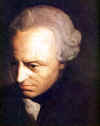 This
position was essentially repeated by later philosophers in the
rationalist tradition, and was best articulated by Immanuel Kant
as late as the 1790s, as part of his proposed synthesis of
idealism and empiricism.
This
position was essentially repeated by later philosophers in the
rationalist tradition, and was best articulated by Immanuel Kant
as late as the 1790s, as part of his proposed synthesis of
idealism and empiricism.
Kant began his argument by outlining his criteria for a true science.
In Kant's view, psychology failed on all counts:
Therefore, the only possible psychology is anthropological in nature, based on observation of behavior, not introspection on one's mental states -- which is why Kant entitled his last book, which really stands as the first introductory textbook of psychology, Anthropology from a Pragmatic Point of View (1898).
Now of course one can argue with each of these points, but Kant's views were widely accepted, with the result that there were few attempts to go beyond philosophical speculation and argument.
In the middle of the 19th century, however, the
Kantian position began to be challenged, by scientists who
believed that it was possible to control and measure mental
states after all. The first steps in this direction were
taken by the invention of psychophysics, which examines
the relation between the physical properties of a stimulus and
the corresponding perceptual experience. The result was a
set of controlled experimental procedures and a series of
mathematical laws that proved Kant wrong: mental states could be
measured after all:
Take that, Manny.
Based on psychophysicists' success, Wundt claimed
that psychology could be a science after all -- but that there
were limits.
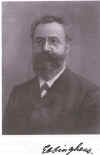 It fell to Hermann
von Ebbinghaus to prove Wundt wrong. Ebbinghaus read
Fechner's Elements of Psychophysics, was impressed with
the accomplishments of the new science of the mind, and decided
to do the same thing for the "higher" mental processes, starting
with memory. Interestingly, Ebbinghaus was not part of
Wundt's circle: Although inspired by Fechner, and aware of
Wundt, he worked entirely alone, and began his work before he
had obtained any academic position at all.
It fell to Hermann
von Ebbinghaus to prove Wundt wrong. Ebbinghaus read
Fechner's Elements of Psychophysics, was impressed with
the accomplishments of the new science of the mind, and decided
to do the same thing for the "higher" mental processes, starting
with memory. Interestingly, Ebbinghaus was not part of
Wundt's circle: Although inspired by Fechner, and aware of
Wundt, he worked entirely alone, and began his work before he
had obtained any academic position at all.
So, Ebbinghaus built everything up from scratch.
Ebbinghaus' general method was as follows:
With this general method in hand, Ebbinghaus proceeded to collect the first experimental data on human learning and memory.
One set of
experiments examined the speed of learning as a function of list
length. Ebbinghaus would vary the length of the list to be
learned, from 7 to 36 items, and measure the number of trials to
a criterion of 1 complete recitation. He observed an
initial steep increase in learning time, followed by a gradual
flattening out.
Another
experiment
determined that learning was faster when the material was
meaningful. For this purpose, Ebbinghaus memorized stanzas
of Byron's Don Juan, each of which consisted of 80
syllables. Based on his previous experiment, he then
estimated by extrapolation how long it would take him to
memorize 80 nonsense syllables -- indicating a clear advantage
for meaningfulness.
On the memory side,
Ebbinghaus also examined retention as a function of
repetitions. After learning a standard list to a criterion
of 1 perfect recitation, he would vary the number of
additional repetitions during the learning phase, wait for 24
hours, and then measure memory by the savings method. The
more repetitions at the time of initial learning, the less time
was needed to relearn the list a day later.
And also retention as a function of the
interval between learning and test. After learning a list
to his standard criterion of 1 perfect recitation, he would
relearn the list after intervals ranging from 19 minutes to 1
month. The result was the first mathematical model of a
"higher" mental process, in which retention was an inverse
function of the logarithm of time: Memory, no less than sensory
experience and perception, conformed to mathematical laws.
b = 100k / (log t)c + k |
where:
b = savings (%) t = retention interval (in minutes) k = a constant c = another constant
|
Finally, Ebbinghaus
discovered "savings" in savings in relearning. Recall that
his relearning experiments required relearning previously
memorized material -- raising the question of whether relearning
got easier on subsequent attempts. In this experiment,
Ebbinghaus compared lists of 12, 24, and 36 CVCs vs. 1 (80
syllable) stanza of Don Juan. He learned and then
relearned the material over six successive days, and found that,
despite the constant retention interval, the number of
repetitions required for re learning decreased steadily.
So far, all these findings are strictly empirical: they reveal various phenomena, such as the laws of repetition and retention, but don't bear on any particular theory of learning. In a final series of experiments, Ebbinghaus made an original theoretical contribution concerning the nature of associations.
Ebbinghaus began his work from a position of associationism,
which assumed that learning proceeds by forming associations
between items on the study list. And memory proceeds by
unpacking these associations -- each remembered item eliciting
another, associated one. But what was the nature of these
associations?
Remote
Associations. Associations are only formed between
immediately contiguous items; more remote associations are
mediated by immediate ones. Thus, when a subject learns a
list A-B-C-D, the association between A-D is mediated by
associations between A-B, B-C, and C-D. But are there
direct associations between remote items?
To
address
this question, Ebbinghaus memorized a list of associations, such
as
and then examined "savings" in learning derived lists created by skipping one or more items, compared to a control list which had the same items at the beginning and end, but random items in between, such as
Note that this is not exactly an experiment in savings, because the derived list is different from the original list. Rather, it is more properly regarded as an experiment in transfer of training -- how learning one thing affects the learning of another.
The result was that transfer occurred, as a
decreasing function of the remoteness of the derived list from
the original. That is, there was more transfer with skips
of 1 or 2 than with skips of 3 or 7. This showed that the
associations formed during learning were not limited to
immediately contiguous items, but also extended to more remote
items.
Reverse Associations.
Associations proceed in a forward manner, from earlier to
later. Thus, associations are formed from A-B, B-C, and
C-D. But are backward associations formed as well, from
D-C, C-B, and B-A?
To address this question, Ebbinghaus again
learned one list, A-B-C-D-E, and then used "savings" to measure
transfer to the reverse, E-D-C-B-A, compared to a control in
which the first and last items were kept constant, and other
items randomly interspersed in between.
He also performed similar experiments with lists that skipped one item, examining remote reversed associations).
The result was that
there was significant transfer to the reversed list, but less
than in the forward case. There was also significant
transfer on the remote reversed list. Thus, both immediate
and remote associations are to some extent bidirectional.
Ebbinghaus was founding editor of the Zeitschrift fur Psychologie (1890), an important journal for psychological research -- not least because it was independent of Wundt and his school. And he also wrote an important textbook, the Grundzuge der Psychologie (1897-1902).
After receiving an academic appointment, Ebbinghaus completed his story of memory, and then moved on to other topics such as color vision and the development of tests of mental aptitude (this last is 1897, before Binet's work in France). At this point, the study of human learning and memory was largely taken up by others.
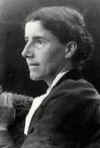 Chief among these
early investigators was Mary Whiton Calkins (1863-1930),
who studied under William James, but was denied a PhD from
Harvard on the grounds that it didn't admit women. She was
offered a degree from Harvard's (then) "sister" institution for
women, the Radcliffe Institute (where James and other Harvard
professors lectured to earn extra money), but she refused the
degree on the grounds that she had earned a Harvard degree, and
that's what she wanted. nevertheless, she became a
professor of psychology at Wellesley College, and the first
female president of the American Psychological Association.
Chief among these
early investigators was Mary Whiton Calkins (1863-1930),
who studied under William James, but was denied a PhD from
Harvard on the grounds that it didn't admit women. She was
offered a degree from Harvard's (then) "sister" institution for
women, the Radcliffe Institute (where James and other Harvard
professors lectured to earn extra money), but she refused the
degree on the grounds that she had earned a Harvard degree, and
that's what she wanted. nevertheless, she became a
professor of psychology at Wellesley College, and the first
female president of the American Psychological Association.
Calkins' contribution to the early study of learning and memory was to invent the paired-associate technique, in order to focus the study of learning on pairs of items -- in this case, a color and a numeral. Using this technique, Calkins studied the effects of frequency, recency, primacy, and vividness on learning and memory. In her studies, she showed that subjects can learn particular associations independent of all others, without depending on "remote" associations created by a series of interlinked items.
Calkins' technique of paired-associate learning
was employed by Muller &
Pilzecker (1900), in large part because it fit perfectly into
the stimulus-response analysis of animal learning emerging from
the laboratories of Pavlov and Thorndike. Through their
experiments,
Ironically, the emphasis on paired-associate learning was coincidental with the triumph of Watson's stimulus-response behaviorism (1913, 1919), and a shift in psychological interest from human memory to animal learning. But some investigators continued to study human learning and memory, mostly using nonsense syllables and paired associates.
Another important early investigation was by
Bryan and Harter (1897, 1899) on the acquisition of skill
(procedural knowledge) in Morse code. Their primary
discovery was that the learning curve is marked by
plateaus. Their work on human learning actually antedated
experimental studies of animal learning by Pavlov and Thorndike
(both 1898).
None of these investigators attempted to link their behavioral studies with physiology -- with what is going on in the brain during the learning process. This line of inquiry was carried out in the neurological clinic, with pioneering studies of the "organic" pathologies of memory resulting from brain insult, injury, or disease.
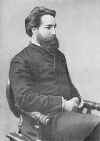 Most
famously, Korsakoff (1889a & b) described a specific memory
disorder observed in chronic alcoholics, and characterized by four features:
Most
famously, Korsakoff (1889a & b) described a specific memory
disorder observed in chronic alcoholics, and characterized by four features:
Korsakoff observed that there was a relative sparing of other intellectual abilities, such a general intelligence (which distinguishes amnesia from dementia) and sensory-perceptual functions (which ruled out aphasia or paralysis secondary to stroke).
Korsakoff did not know what brain pathology was involved, but the specific deficit in amnesia suggested to him that perception, memory, and intelligence were dissociable, and thus mediated by distinct brain systems.
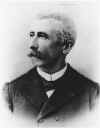 But
even before Korsakoff -- and before Ebbinghaus, too, for that
matter -- Theodule Ribot (not to be confused with the
19th-century French painter of the same name) attempted to
derive fundamental laws of memory from the study of
pathology. This was part of a larger project intended to
illuminate normal functioning through pathology, which resulted
in three volumes Diseases of Memory (1882), the
most famous and influential; Diseases of Will (1884), in
which Ribot coined the term anhedonia; and Diseases
of the Personality (1885). In the memory book, as in
the others, Ribot reported no controlled experiments, or even
any original clinical observations. Instead, he provided a
careful analysis of cases reported by others.
But
even before Korsakoff -- and before Ebbinghaus, too, for that
matter -- Theodule Ribot (not to be confused with the
19th-century French painter of the same name) attempted to
derive fundamental laws of memory from the study of
pathology. This was part of a larger project intended to
illuminate normal functioning through pathology, which resulted
in three volumes Diseases of Memory (1882), the
most famous and influential; Diseases of Will (1884), in
which Ribot coined the term anhedonia; and Diseases
of the Personality (1885). In the memory book, as in
the others, Ribot reported no controlled experiments, or even
any original clinical observations. Instead, he provided a
careful analysis of cases reported by others.
Ribot began his analysis by delineating three
aspects of memory:
The distinction between retrieval and recollection led Ribot to distinguish between organic and psychical memory. Memory need not entail conscious recollection, in terms of the localization of an event in past experience. Ribot noted that many nonhuman animals have some capacity for memory, which enables them to learn from experience. But the capacity for conscious recollection is an added complexity -- one which may be uniquely human.
Writing before Korsakoff had announced his syndrome, Ribot identified several different syndromes of memory impairment.
Temporary amnesia was observed under two
conditions:
Periodical amnesia included the interpersonal amnesia associated with multiple personality.
Progressive amnesia was associated with dementia.
Congenital amnesia was associated with mental retardation.
Ribot also described various forms of partial
amnesia:
And finally, Ribot described hypermnesia, in which the patient had exceptionally good memory (either general or partial).
On the basis of his reading of the clinical literature, Ribot formulated his law of regression, that "the general dissolution of memory follows an invariable path":
Further, Ribot believed that the "partial dissolution" of memory in language also followed an invariable path:
The general pattern of the destructive process was
characterized as a regression (note that this was long before
Freud):
Ribot believed that his law of regression was confirmed by rare cases of recovery, as he believed that recollections returned in the reverse order from that in which they disappeared. Thus, he traced the following path of recovery from the retrograde amnesia associated with "cerebral shock":
The hypermnesias provided a further illustration of the law of regression (in reverse). As "the mind turns backward" to earlier conditions of existence, memory improves for the oldest, simplest, most automatic, and best organized contents.
Ribot's law was formulated to be consistent with a general biological principle that the most recently formed structures are the first to degenerate. This principle was applied to the brain by John Hughlings Jackson (1835-1911), an early English neurologist, in an evolutionary analysis of cortical function. The "higher" cortical functions are the last to appear in evolution, and so they are the first to disappear in disease. Similarly, simple functions are the last to go. In this way, Ribot adduced a parallel between the laws governing psychological and biological functions.
The stream of thought flows on; but most of its segments fall into the bottomless abyss of oblivion. Of some, no memory survives the instant of their passage. Of others, it is confined to a few moments, hours, or days. Others, again, leave vestiges which are indestructible, and by means of which they may be recalled as long as life endures.
![]() The First Golden Age of
Memory culminated in 1890, with the publication of James' Principles
of Psychology -- and specifically James' Chapter 16, on
"Memory". James cited Ebbinghaus' "really heroic
series of daily observations", as well as Ribot's analyses of
memory disorders. But the heart of James' analysis of
memory, as in the rest of the really interesting parts of the Principles,
rests on introspection. James maintained a teaching
laboratory full of "brass instruments", but he himself disliked
experimentation, and preferred to rely on introspective analyses
of mental life.
The First Golden Age of
Memory culminated in 1890, with the publication of James' Principles
of Psychology -- and specifically James' Chapter 16, on
"Memory". James cited Ebbinghaus' "really heroic
series of daily observations", as well as Ribot's analyses of
memory disorders. But the heart of James' analysis of
memory, as in the rest of the really interesting parts of the Principles,
rests on introspection. James maintained a teaching
laboratory full of "brass instruments", but he himself disliked
experimentation, and preferred to rely on introspective analyses
of mental life.
Actually, introspection is not quite the right term, because James understood that all introspection is retrospection:
All the intellectual value for us of a state of mind depends on our after-memory of it. Only then is it combined in a system and knowingly made to contribute to a result. Only then does it count for us. So that the EFFECTIVE consciousness we have of our states is the after-consciousness; and the more of this there is, the more influence does the original state have, and the more permanent a factor is it of our world.
James began by distinguishing between two aspects of memory, primary memory and secondary memory.
Primary memory refers to the mental
representation we have of an object or event, after it has
disappeared from the sensory field. James' model for
primary memory is the visual after-image, which persists after
the stimulus has been terminated.
Primary memory persists as long as we pay attention to it. Once our attention has been deployed elsewhere, it quickly disappears from consciousness.
An object which is recollected, in the proper sense of that term, is one which has been absent from consciousness altogether, and now revives anew. It is brought back, recalled, fished up, so to speak, from a reservoir in which, with countless other objects, it lay buried and lost from view. But an object of primary memory is not thus [p. 647] brought back; it never was lost; its date was never cut off in consciousness from that of the immediately present moment. In fact it comes to us as belonging to the rearward portion of the present space of time, and not to the genuine past. In the last chapter we saw that the portion of time which we directly intuit has a breadth of several seconds, a rearward and a forward end, and may be called the specious present. All stimuli whose first nerve-vibrations have not yet ceased seem to be conditions of our getting this feeling of the specious present. They give rise to objects which appear to the mind as events just past.
Secondary memory, then, refers to the mental representation of an event after it has once disappeared from consciousness:
Memory proper, or secondary memory as it might be styled, is the knowledge of a former state of mind after it has already once dropped from consciousness; or rather it is the knowledge of an event, or fact, of which meantime we have not been thinking, with the additional consciousness that we have thought or experienced it before.
In distinguishing between "primary" and "secondary" memory, James laid the foundation for the cognitive revolution in the study of memory in the 1960s, and its distinction between short- and long-term memory stores. Waugh and Norman (1965), for example, explicitly adopted James' terminology in their multistore model of memory.
For James, then, memory proper consists of some sort of mental copy of an event, combined with the knowledge that the event in question is located in the past rather than the present. But not merely the past in the abstract:
Memory requires more than mere dating of a fact in the past. It must be dated in my past. In other words, I must think that I directly experienced its occurrence. It must have that 'warmth and intimacy' which were so often spoken of in the chapter on the Self, as characterizing all experiences 'appropriated' by the thinker as his own.
Viewed in symbolic terms, every memory consists of a description of an event, linked to a marker indicating that the event occurred in the past, and also linked to a representation of oneself as the agent or patient, stimulus or experiencer, of that event. Without that self-reference, the memory is more properly referred to as knowledge -- or what Endel Tulving would call semantic memory.
James then notes that the act of remembering entails two quite different things: first, the retention in memory of "the remembered fact" plus its "reminiscence, recollection, reproduction, or recall". James construes what we would now call the retrieval phase of memory processing as a search, guided by associative pathways.
In short, we make search [sic] in our memory for a forgotten idea, just as we rummage our house for a lost object. In both cases we visit what seems to us the probable neighborhood of that which we miss. We turn over the things under which, or within which, or alongside of which, it may possibly be; and if it lies near them, it soon comes to view. But these matters, in the case of a mental object sought, are nothing but its associates. The machinery of recall is thus the same as the machinery of association, and the machinery of association, as we know, is nothing but the elementary law of habit in the nerve-centres.
Moreover, James asserts that the success of recollection is determined by the number of facts associated with the to-be-remembered fact - -and the more the better. Here we can see the foreshadowing of the principles of elaboration and organization governing the encoding process, and the principle of cue-dependency governing the retrieval process (all of which are discussed in detail later in this course). By means of elaboration and organization, we establish multiple links between the memory trace and other knowledge already stored in memory; and by means of cue-dependency, we trace associative links from the cue to contact the memory trace.
It will now appear clear that all improvement of the memory lies in the line of ELABORATING THE ASSOCIATES of each of the several things to be remembered.
Interestingly, James was pessimistic about the sorts of mnemonic devices used by ancient orators. He believed that individual differences in "general retentiveness" were essentially innate and immutable. True, practice and mnemonic devices could improve memory for the specific things practiced, or for the specific things included in the mnemonic device, but James doubted that the effects would generalize to new material. For James, memory is not a "mental muscle" that can be strengthened by use, and weakened through disuse.
Similarly, James -- this is the 19th century! -- cautioned students against "cramming" for exams:
The reason why cramming is such a bad mode of study is now made clear. I mean by cramming that way of preparing for examinations by committing 'points' to memory during a few hours or days of intense application immediately preceding the final ordeal, little or no work having been performed during the previous course of the term. Things learned thus in a few hours, on one occasion, for one purpose, cannot possibly have formed many associations with other things in the mind. Their brain-processes are led into by few paths, and are relatively little liable to be awakened again. Speedy oblivion is the almost inevitable fate of all that is committed to memory in this simple way. Whereas, on the contrary, the same materials taken in gradually, day after day, recurring in different contexts, considered in various relations, associated with other external incidents, and repeatedly reflected on, grow into such a system, form such connections with the rest of the mind's fabric, lie open to so many paths of approach, that they remain permanent possessions. This is the intellectual reason why habits of continuous application should be enforced in educational establishments. Of course there is no moral turpitude in cramming. If it led to the desired end of secure learning it would be infinitely the best method of study. But it does not; and students themselves should understand the reason why.
James also argued that "In the practical use of our intellect, forgetting is as important a function as recollecting".
This peculiar mixture of forgetting with our remembering is but one instance of our mind's selective activity. Selection is the very keel on which our mental ship is built. And in this case of memory its utility is obvious. If we remembered everything, we should on most occasions be as ill off as if we remembered nothing. It would take as long for us to recall a space of time as it took the original time to elapse, and we should never get ahead with our thinking. All recollected times undergo, accordingly, what M. Ribot calls foreshortening; and this foreshortening is due to the omission of an enormous number of the facts which filled them.
Here, I think, James intuits what we will later refer to as the "paradox of interference": the more one knows about some domain, the harder it is to retrieve any particular piece of information:
We thus reach the paradoxical result that one condition of remembering is that we should forget. Without totally forgetting a prodigious number of states of consciousness, and momentarily forgetting a large number, we could not remember at all. Oblivion, except in certain cases, is thus no malady of memory, but a condition of its health and its life."
James, Ebbinghaus, and Ribot are the central figures in the First Golden Age of Memory. But the reference to the "first" Golden Age suggests that there was a second one, and the existence of a second Golden Age implies that there was a not-so-golden age in-between. There was and there was. The second Golden Age came with the cognitive revolution in psychology, stimulated by the computer metaphor of memory and the analysis of brain-damaged patients like H.M. And between the first and second golden ages were the dark days of radical behaviorism, when memory virtually disappeared as a topic for scientific research, to be replaced by verbal learning. But, as we shall see, the verbal-learning tradition was not all dross. There was some gold in "them thar hills", as well.
This page last modified 10/07/2014
.